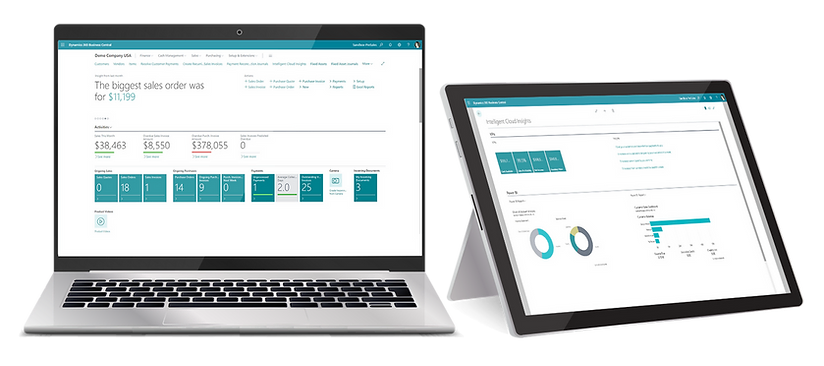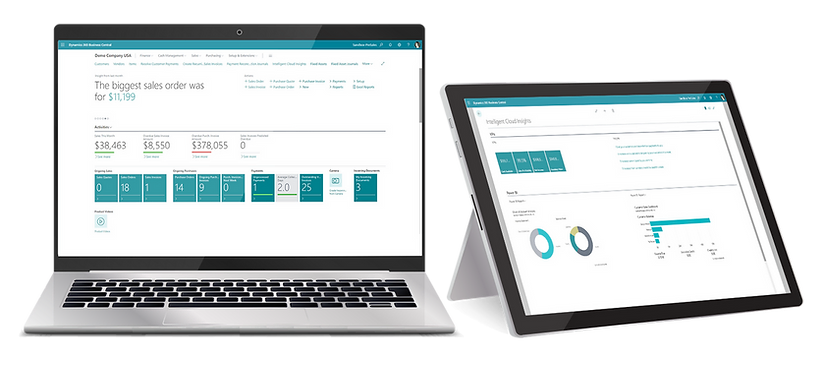Dynamic 365 Business Central
Microsoft Dynamics 365 Business Central. Flexible. Intuitive. Functional.
The best choice for modern business.
Introduction to Microsoft Dynamics 365 Business Central

Rich functionality available in the standard version Microsoft Dynamics 365 Business Central is a comprehensive business solution with outstanding capabilities for process integration. Right from the start, you can experience all the benefits of implementing the system. By using more efficient tools, your Company Hub, Financial Management, Purchasing & Marketing, Warehouse, Projects(jobs), Human Resources, Manufacturing, Business intelligence & E-services, or Manufacturing processes become easier.
The system is offered in two licensing options – Essentials or Premium.
Dynamics 365 Business Central Essentials includes the functionalities from the following areas:
- Company Hub
- Human Resources
- Services
- Warehouse Management
- Manufacturing
- CRM
- Human Resources Management
- Projects
- Purchasing & marketing
- Business Central Essentials
| Financial Management | Marketing/Customer Relationship Management | Supply Chain Management | Project Management | Human Resources Management | Service Management | Manufacturing |
|---|---|---|---|---|---|---|
| Chart of Accounts | Contacts | Sales andPurchase Orders | Resources | Employee registration | Service Items | Production Orders |
| Dimensions | Segmentation | Inventory Availability | Resource Capacity and Availability | Service Contract Management | Service Orders | Version Management |
| Process Payments | Sales Opportunities | Inventory Availability | Jobs | Qualifications and Confidential Information | Service Orders | Agile Manufacturing |
| Cash Flow Forecast | Campaigns | Nonstock Items | Time Sheets | Absence Log | Planning & Dispatching | Supply Planning |
| Budgets | Interactions | Item Substitutions | Employee Expense Management | Service Contract Management | Demand Forecasting | |
| Deferrals | Dynamics 365 for Sales integration | Locations | Service Price Management | |||
| Fixed Assets | Inventory_ Movements | Warranty/font | ||||
| Bank Account Management | Warehouse Management | |||||
| Audit Trails |
Finance management
Plan of the accounts
Dimensions
Payment processing
Cash flow forecast
Audit trails
Accruals
Budgets
Fixed assets
Bank account management
Customer relationship management
Contacts
Segmentation
Deal management
Campaigns
interactions
Integration with Dynamics 365 for Sales
Supply chain management
Management of sales orders and purchase orders
Monitoring and control of the entire purchasing process in Dynamics 365 Business Central is carried out using automated workflows. The registration of documents within flows is supported by the OCR functionality. Replenishment orders are created directly from stock notifications and forecasts. In contrast, prices and discounts are assigned based on conditions agreed with suppliers, which may include, for example, minimum quantities and order date. The implementation of advanced workflow and approval functions allows for even better control of costs and expenses.
Storage
Out-of-stock inventory
Sales and inventory forecasts
Stock substitutes
Locations
Inventory shifts
Stock availability
Project management
Resources
SegmentationPerformance and resource availability
Timesheets
Orders
Service management
Service Items
service orders
Planning and allocation of tasks
Guarantee
Management of service contracts
Service price management
Production management
Bill of Materials (BOM), route and capacity
The production order
Demand forecasting
Production planning
Subcontracting functionality
Advanced production capacity
Workloads
Subcontracting functionality
Advanced production capacity

Modern and friendly interface
Accessible from any place, device, platform

Available in any infrastructure and licensing model
Microsoft Dynamics 365 Business Central on-premises
Lorem ipsum dolor sit amet, consectetur adipiscing elit. Ut elit tellus, luctus nec ullamcorper mattis, pulvinar dIn the case of a perpetual license, the customer acquires the right to use the system license indefinitely. Selecting this option may be beneficial in several cases. First of all, when the organization can incur higher costs at the initial stage of investment and intends to manage its infrastructure internally. Another circumstance occurs when the software will be run locally (or will be covered by license portability, hosted by a third-party provider in the IaaS model).In the case of a license in the form of a subscription, the customer acquires the right to use the software for the period when he will make recurring payments. By choosing this licensing model, the buyer incurs lower initial costs. In addition, it gains more flexibility to increase or decrease the number of subscription licenses in a given term.A subscription-based license may be an appropriate choice when an enterprise would like the obligation to maintain and manage the infrastructure in the cloud model to be taken over by an implementation partner or external service provider. Alternatively, software deployment is performed locally at the customer's organization. However, this is only possible if the partner implementing the Dynamics 365 Business Central 365 on-premises solution provides ongoing support and takes full responsibility for managing the system.apibus leo.
Microsoft Dynamics 365 Business Central on-cloud
The ERP system in this version is available as a service (Software as a Service). This means that all core infrastructure, middleware, and application software and data reside in the Microsoft Azure data center. Microsoft manages the hardware and system and ensures the availability and security of applications and data. This approach allows clients to get started quickly with minimal upfront cost. Microsoft Dynamics 365 Business Central on-cloud is available only as a monthly subscription. It is purchased through the Cloud Solution Provider (CSP) partner network.
A smart cloud for every scenario

Equipped with its built-in high-level security features, Business Central is available as:
(Windows, Android, iOS)
(Windows, Android, iPhone)
(Internet Explorer, Microsoft Edge, Google Chrome, Mozilla Firefox, Safari)
Additional functionalities at your fingertips
AppSource
dozens of ready-made and tested applications that extend the standard functionality of the system, prepared by Microsoft and partners from around the world.
Power BI
- a suite of analytical tools integrated with Dynamics 365 Business Central and based on a cloud platform, which will enable employees of the organization to: sualizations and analytics
- a comprehensive view of the processes being carried out
- fast, simple and secure access to key data
- insight into strategic information from any device
- insight into strategic information from any device
- advanced visualizations and analytics
PowerApps
designed by Microsoft, an efficient and extremely flexible platform supporting the creation of custom business applications. Therefore, designing solutions is extremely simple and fast. Newly created apps can be shared across the organization and accessed from any mobile device.
Microsoft Flow
a platform that enables the management and automation of processes and workflows between Microsoft Business Central and other services and tools.
Extensions
improvements and new functionalities can be created and published in the form of so-called extensions. This approach allows for the development of a standard application without interfering with the source code, which significantly speeds up and facilitates the procedure of updating the system to a new version.
Connect apps
flexible API that allows you to integrate Business Central with third-party solutions and services